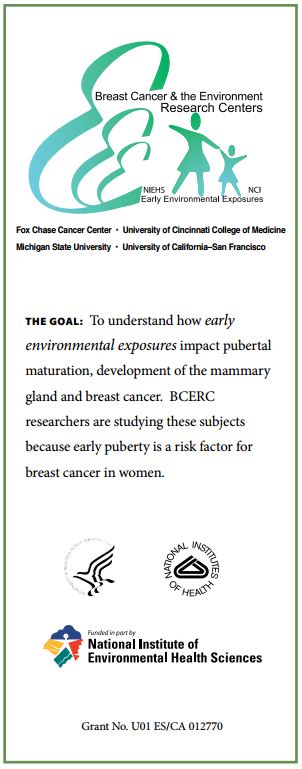Breast Cancer and the Environment
1. Breast Cancer and the Environment Research Program (BCERP)
Environmental exposures and personal susceptibility factors have been shown to be important in breast cancer development. There is great public concern regarding possible environmental factors. Recognizing that the origins of breast cancer likely occur early in life and during times of rapid breast development, researchers need to learn more about exposures that are most influential during critical windows of susceptibility, such as puberty.
To address this complex problem in innovative ways, the National Institute of Environmental Health Sciences (NIEHS) and the National Cancer Institute (NCI) co-fund the Breast Cancer and the Environment Research Program (BCERP) to study environmental exposures that may predispose a woman to breast cancer throughout her life.
BCERP supports a multidisciplinary network of scientists, clinicians, and community partners to examine the effects of environmental exposures that may predispose a girl or a woman to breast cancer throughout her life. The program engages both laboratory and population-based research to study puberty and other “windows of susceptibility”, specific time periods when the developing breast may be more vulnerable to environmental exposures.
2. BCERP Research at Michigan State University
Michigan State University researchers Drs. Sandra Haslam and Richard Schwartz have been funded by the BCERP program since its inception in 2003.
The third phase of BCERP-funded research at MSU, which began in December 2015, is focused on Mammary Carcinogenesis: Pubertal and Adult Effects of High Fat Diet + Oxybenzone (a common ingredient in sunscreen and other personal use products).
Puberty and young adulthood are periods of high susceptibility to environmental and lifestyle factors that increase breast cancer risk. The research team is identifying how a high animal fat diet (HFD) consumed during puberty or young adulthood increases breast cancer risk. Ovarian hormones are implicated in the etiology of breast cancer. Estrogenic endocrine-disrupting chemicals may act as agonists or antagonists during mammary gland development and mammary tumorigenesis and should be studied to evaluate their potential in promoting breast cancer.
The researchers are studying the interaction of HFD with a widely used but understudied endocrine-disrupting chemical, oxybenzone (benzophenone-3, BP-3) – a common ingredient in sunscreen and other personal use products with potential estrogenic activity, to affect breast cancer risk. Recently, HFD was shown to increase premenopausal breast cancer risk in normal weight, but not overweight, young women. This agrees with the research team’s published and preliminary studies identifying both pubertal and adult windows of susceptibility to the promotional effects of HFD in obesity-resistant BALB/c mice. Of note, HFD promoted basal-like breast cancer, which also predominantly occurs in young women. The pubertal window of susceptibility for HFD tumor promotion indicates the potential efficacy of early age preventive intervention to reduce adult breast cancer risk.
3. Ecology Center, MI.
Ecology Center, MI. A great source of info about safe & healthy materials.
